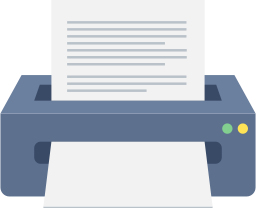
Printer – External & Peripheral Hardware
A printer is an essential external peripheral hardware device that produces physical copies of digital content by transferring text or images onto paper or other printable media. It connects to a computer, mobile device, or network and functions as an output device in various environments such as offices, schools, homes, and industrial settings. Printers play a critical role in document production, offering both monochrome and color output in a wide range of formats.
Key Features and Characteristics of Printers:
Converts digital documents into physical copies
Connects to devices via USB, Ethernet, Wi-Fi, Bluetooth, or cloud-based services
Available in different types such as inkjet, laser, dot matrix, thermal, and 3D printers
Inkjet printers are commonly used for photo printing and general home use due to their color quality and affordability
Laser printers are preferred in offices for their speed, efficiency, and sharp text printing
Dot matrix printers are used in specialized applications like receipts or multi-part forms
Thermal printers are typically used in retail and point-of-sale systems for label and receipt printing
3D printers build physical objects layer by layer from digital 3D models, used in prototyping and manufacturing
Some printers offer multifunctionality, including scanning, copying, and faxing in a single device
Compatible with most operating systems and support plug-and-play or driver installation
Common Applications of Printers:
Producing physical copies of reports, letters, contracts, and presentations
Printing photographs, brochures, marketing materials, and posters
Creating educational materials, worksheets, and assignments in schools and universities
Used in legal, government, and financial institutions for printing official documents and records
Facilitating remote work by enabling employees to print important materials from home
Supporting healthcare environments for printing prescriptions, test results, and patient records
Used in retail and logistics for printing receipts, invoices, and shipping labels
Employed in creative fields to produce high-quality prints of artwork or digital designs
3D printing used for producing prototypes, replacement parts, and customized items in engineering and design
Assisting small businesses in generating promotional materials and customer documentation
Cost and Accessibility:
Printers vary widely in price depending on type, features, and print capacity
Basic inkjet models are affordable and accessible for personal or occasional use
Laser printers and multifunction devices have higher upfront costs but lower per-page printing costs
3D printers are more expensive and generally used in professional or technical environments
Additional costs may include ink or toner, paper, maintenance, and replacement parts
Some printers offer refillable ink tanks, reducing long-term printing expenses
Cloud printing or mobile printing apps may be free or require subscription depending on the brand or service
Initial hardware purchase is required, and ongoing usage costs depend on frequency and volume of printing
Comparison with Other Output Devices:
Printers provide a physical output, unlike monitors or projectors that display content temporarily
Compared to digital sharing methods like email or cloud storage, printed documents offer a tangible and often more formal presentation
Printers are more suitable for legal and archival purposes than digital screens
In contrast to handwriting, printed documents are more legible and professional
While digital displays are eco-friendly, printers still hold value in situations where physical copies are necessary
Conclusion:
Printers remain an indispensable part of modern hardware ecosystems, enabling the transition from digital to physical formats in countless industries and settings. Whether for basic document printing or complex manufacturing tasks, printers fulfill a wide range of needs. The type of printer selected depends on the specific application, budget, and performance requirements. Although they involve both initial and ongoing costs, their practical benefits justify the investment. Despite the rise of digital alternatives, printers continue to play a key role in business operations, education, creative work, and everyday life, offering reliability, versatility, and efficiency in output.












